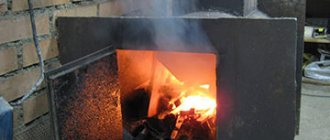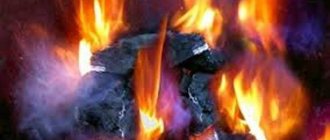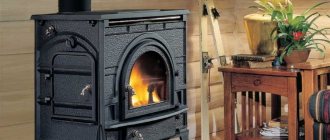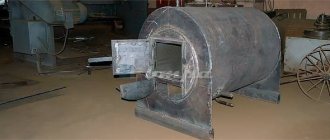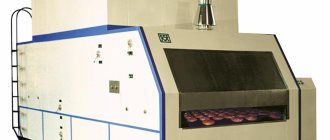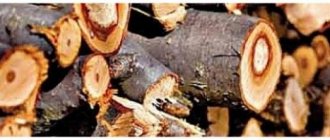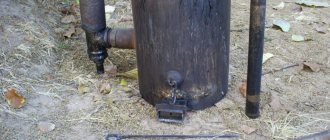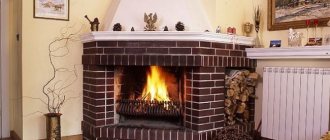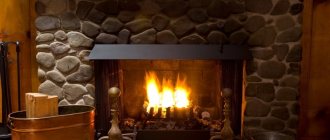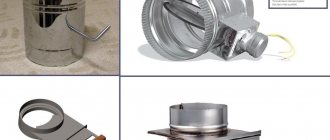Heating devices are not always used constantly. Many homeowners visit their vacation homes for a season, such as in the spring. Residents of Russia will go to their country houses and dachas to spend time there calmly and usefully. Many have already gone to live in the countryside - it is safer there, there is fresh air and nature.
In order to spend time in a country house or country house in comfort, you need a fireplace, stove or boiler. Indeed, in our climate, not only in spring, but even in summer it can be cool, especially at night. Many homeowners already have heating devices installed, but after a long period of inactivity they require some care and approach. This article will discuss methods for lighting a stove or fireplace after a period of prolonged non-use.
Why does the fireplace fail to melt or smoke after a long period of inactivity?
First, let's look at the reasons why a heating device that has not been used for a long time does not heat well and smokes at the beginning of the season. The fact is that during the winter the chimney of a stove or fireplace becomes very cold and damp. The pipe can freeze so much that the air temperature inside it is lower than outside or in the house. Based on physical laws, cold oxygen in the smoke duct does not rise up the pipe. In other words, there is practically no draft in a cold pipe. To light a stove complete with a frozen chimney, you need to expel the cold air.
Methods for warming up a frozen pipe:
- The first method is to eliminate the difference in air temperature inside the pipe and outside - in the room. The method is suitable for rooms with positive air temperatures. Open the door of the combustion chamber of the hearth, as well as the windows and doors in the room, so that warm air enters the room, and a draft provokes the movement of air masses inside the firebox and chimney.
- The second and main method is to warm up the chimney route. The material and design of the pipe do not matter, the process itself is important. A lit newspaper or paper should be placed in the chimney sweep door. To get the effect, you need to burn several newspapers or sheets of paper at once. The achievement of the effect should be noticeable by the behavior of the newspaper and the flame - they should be actively drawn into the smoke channel using the draft force activated after heating the pipe.
- You can also warm up the chimney using the furnace or fireplace itself. Instead of firewood, newspapers or paper should be placed in the firebox and several batches of this simple fuel should be burned. A slight but warm flame from a newspaper or paper will warm up the pipe, expel cold air into the street and normalize the draft level. As in the second method, the achievement of the effect will be noticeable by the behavior of the flame - it should tend inward and upward, towards the chimney.
- After the chimney has warmed up, you can try to carefully begin the lighting process. To do this, place a small amount of wood chips (be sure to be dry) in the firebox and light them. If the wood chips are well burned and the smoke goes up the chimney, you can start lighting the main fuel - firewood.
Attention! After heating the smoke channel through the inspection, cleaning holes and doors, they should be closed to prevent smoke and carbon monoxide from entering the room.
Features of the combustion chamber of different types of furnaces
There are several types of stoves, depending on the material:
- Made of stainless steel;
- Cast iron;
- Brick.
How to properly heat a metal stove?
More often, these heating devices are found in bathhouses, but there are often cases when residents of ordinary rural houses build them for themselves. It is imperative to take into account the temperature in the wood burning stove when working with such a structure. Although such stoves are small in size, not every owner knows how to heat them in order to maintain heat in the room for a long time.
The general rules are identical for all types of stove structures, so do not be afraid of this matter - there is absolutely nothing complicated in it, every master can do it if desired:
It is important to remember that when working with metal stoves, there are several important restrictions that must be met immediately when starting work. First of all, in order to properly light the stove with wood without wasting it, you should not use flammable mixtures sold in stores to water the wood. This has an extremely negative impact on both the environment and the general health of the stove maker - an excessive abundance of chemicals, as well as the forced need to breathe their vapors for a long time, have not benefited anyone. Prefer to these auxiliary products special alcohol tablets, sold in the same section of the supermarket as lighter fluid - they burn for a long time
Thanks to them, firewood ignites quickly, easily, and also has a much lower level of toxicity. They can be used if there is a need to work with poorly dried firewood.
Features of working with a cast iron stove
One of the main rules for working with such a stove is to keep the doors and the blower structure tightly closed. The device for regulating the air draft must remain wide open - this is the only way to ensure the best quality of work with a stove of this type. In order to properly stack firewood in the stove, without fear of getting thermal burns, purchase special gloves to protect the skin of your hands, and an apron so as not to contaminate your clothes with soot. Be sure to take precautions during work - when loading each new portion of firewood, you must carefully open the doors, in no case in a hurry - the intra-stove pressure must certainly return to normal.
Properly heating a brick stove
In the first half hour of operation, such a structure must be heated very intensively, exactly until the optimal air temperature in the room is reached.
When the desired value is reached, a draft regulator should be installed to avoid a further decrease in temperature. The temperature in the firebox of a wood-burning stove must be stable. This will help significantly reduce raw material costs.
Brick stoves have the largest dimensions compared to other types of heating devices, so only physically resilient people who do not have health problems can work with such a structure. To ensure the smooth functioning of such a stove, you often have to lift heavy objects.
How to properly heat a brick stove with wood in winter?
In order to ensure maximum heat production in a brick kiln during the cold winter period, certain operating conditions must be observed. Keep in mind that in this case you simply need to know how to properly place firewood in the stove - each new load of firewood must take place at intervals of at least forty minutes.
What is important to do before warming up the chimney and pre-firing?
It is extremely important to remember that at the end and beginning of each heating season, regardless of the time of year, a preventive inspection and cleaning of the smoke duct should be carried out. During the period of non-use of the heating device, two things can happen to the chimney:
- Various debris from the street can get into the pipe - branches, bird or insect nests, leaves, pine needles, etc. The possibility of debris entering the pipe is especially high in cases where its head is not equipped with a deflector. Debris inside the smoke duct can clog it and prevent the free passage of smoke from the fireplace to the street, as well as stop the draft. The inability of flue gases to escape into the street will provoke their release into the premises, creating a situation dangerous to the health of residents. However, debris in the chimney can easily ignite and cause a fire in the chimney or, in the worst case, in the house.
- Build-ups of soot and condensation on the inner walls of the pipe can also hinder the free passage of smoke masses and draft. To eliminate risks when lighting a heating device after a long period of inactivity, experts recommend conducting a routine inspection of the pipe and, if necessary, cleaning the chimney. These actions can be carried out independently, but it is better with the help of professionals. A chimney cleaning service ordered from a specialized company will be performed efficiently and in compliance with all required, established fire and technical safety standards. At the same time, reliable quality guarantees are always provided for services of this type, ordered from trusted contractors.
Chimney cleaning before the start of the heating season by specialists
The chimney cleaning service is available in: heating industry specialists will carry out a full range of measures for servicing the chimney:
- Inspect the internal contour of the chimney for the presence/absence of dirt, debris, soot build-up and condensation. Cleaning the internal circuit from any detected contaminants using special devices.
- Inspection of the external contour of the chimney for the presence/absence of damage, cracks, depressurization, inspection of the condition of joints and fastenings, insulation. Eliminate any detected defects and damage promptly.
- Lighting up the heating device, checking the draft level, the quality of the flue gas output, comprehensive testing of the performance and safety of heating and smoke exhaust equipment.
- Drawing up a certificate of work performed and providing warranty obligations.
Attention! If you clean the smoke duct yourself, it is recommended to follow fire and technical safety measures, as well as use specialized devices - a brush, a cable with a load, and others.
How do you know that everything is fine with the chimney and you can start lighting the fireplace?
After inspecting and cleaning the smoke channel from debris and contaminants, you can proceed to the stage of heating the pipe, described above. After burning newspapers in the cleanout doors or in the firebox itself, you should put a small amount of firewood in the hearth and carefully light it. As soon as the fuel sets and starts to burn, you need to go outside and watch the head of the pipe on the roof.
- If smoke comes out of it, then everything is in order, the air in the pipe is heated, the draft is working, and the fireplace or stove is ready for use on an ongoing basis.
- If smoke does not come out of the chimney, then most likely most of it is already in the room or accumulating in the chimney. The absence of smoke coming out of the roof part of the pipe indicates that the smoke channel is dirty, clogged, or poorly heated. If, upon returning to the house, no smoke is detected in the room, try warming the pipe again using newspapers or paper.
- If the above method does not help, you should start cleaning the chimney - yourself or with the assistance of a professional chimney sweep. In this case, it is impossible to heat the fireplace any further.
Attention! If during the initial kindling of firewood there is no smoke coming out of the roofing part of the chimney, you should immediately extinguish the flame in the combustion chamber of the stove or fireplace to prevent smoke and carbon monoxide from entering the room. If smoke has already entered the room, you need to extinguish the flame and thoroughly ventilate the room.
Preparatory process
Lighting up a Russian stove is a kind of ritual that does not tolerate fuss and haste. You definitely need to prepare kindling, dry firewood, open the view and check the draft.
Which firewood to choose?
I remember well how firewood for the Russian stove was stacked in a separate woodpile in the woodshed. Dry logs of the same length and fairly even were selected. If you suddenly came across wet firewood, it would burn poorly and smoke terribly, making it difficult to breathe in the rooms. Of the trees, preference was given to birch; it burns evenly and hotly and releases a large amount of heat.
Deciduous wood also burns well and leaves a minimum of soot: oak, ash, beech. Now Russian stoves have begun to be heated with peat briquettes, pressed shavings and straw. But you can’t do without firewood. For sufficient heat, several logs are first burned to form coals, only then briquettes are placed on top.
Oak firewood
How to prepare kindling?
A supply of birch bark and finely chopped splinters should always be stored in the flood chamber. On occasion, birch bark is brought from the forest or peeled with a sharp knife from already split logs. Splinters, the size of pencils, are split with a sharp knife or hatchet from smooth, knot-free logs.
Tip: how to check draft in a Russian stove. Pull the viewer out as far as possible, light a match near the blower door and watch the flame. If the smoke from a lit match goes into the ashpit, this indicates good draft. The smoke is not drawn out completely, the room smells burnt, which means the draft is not strong enough. In this case, it is better to postpone firing the stove until the evening (when it becomes cooler) or the weather changes.
How much fuel should I put in at one time?
The basic rule here is this: you need to fill two-thirds of the firebox volume with firewood. In this case, the logs are not stacked tightly, leaving gaps between them. If you lay out firewood in a well, then two or three tiers, 8 or 12 pieces, are enough. When kindling, thinner, smoother and well-dried wood is used. During the combustion process, fuel briquettes and lower quality firewood are added.
Firewood in the firebox
How to properly light a stove after a long period of inactivity
In case of a successful outcome of the first combustion, there is a good level of draft and free smoke exit through the chimney, it is recommended not to overload the stove. The fact is that during idle time the heating device cools down greatly, especially in the winter season. If you overheat a stove or fireplace insert, prolonged exposure to high temperatures can lead to damage to the heating unit: cracks, bursting of stone or brick masonry parts, cracking of seams and other damage.
When lighting for the first time, consider the following professional advice:
- The recommended duration of the first heating of a stove or fireplace is no more than one hour.
- Then you should let the fireplace “rest”: you need to close the firebox door and the damper on the chimney and leave the device alone for three to four hours. During this time, the generated heat will be smoothly distributed throughout the oven.
- After three to four hours, you can light the stove again. The second heating time should again be no more than one hour. At this hour, it is recommended to keep the firebox door closed and not add firewood so that air from the room does not enter the firebox and cool the fireplace.
- After the second heating, you need to close the firebox door and damper again and give the stove several hours for the new heat to be smoothly and evenly distributed throughout the body and functional parts of the fireplace.
Fuel types
In general, the Russian stove belongs to the category of solid fuel. Several types of resources can be used to kindle them:
- coal. The most effective is stone, but it is rarely used for private houses,
- peat. It burns well, but leaves behind a lot of ash and is not particularly efficient,
- pellets. Granules made from wood waste by hot pressing,
- eurowood. Essentially the same as pellets, but made in the form of bars.
All these types of fuel are environmentally friendly, they are convenient to use and are not too expensive. But the championship in the ranking is held by another resource, which from time immemorial has been used to maintain a fire in the hearth - wood.
Logs are the optimal type of fuel for a Russian stove. They burn for quite a long time, giving off a large amount of heat. From an environmental point of view, there are no questions about them; firewood is absolutely harmless to the environment. This fuel is available almost everywhere and comes at a low price.
Of course, there are also disadvantages. For example, firewood has a fairly high level of humidity and produces a lot of smoke when burning. In addition, they take up a lot of space, so you have to allocate a separate area or room for storing supplies.
However, these disadvantages do not make firewood less popular. If you choose the right logs, you will get excellent, highly efficient fuel. There are several main selection criteria:
- humidity. Firewood for lighting the stove must be absolutely dry. If you purchase them somewhere, then pay attention to this point. If you harvest it yourself, then know that after cutting, the logs must lie for at least a year, only then will they dry to the required level. During drying, they need to be fully protected from possible getting wet. To do this, the woodpile is placed in a covered shed or under an outdoor shed. If you put wet logs in the firebox, they will, of course, still burn. But at the same time, the moisture contained in them will turn into steam, which will first cool the walls of the chimney and then settle on them in the form of condensation. As a result, under constant exposure to water, the stove will begin to collapse. Therefore, special attention must be paid to the dryness of the logs.
- density. One of the important qualities of firewood is the duration of combustion. The speed of this process depends on the density of the wood. The higher this indicator, the longer the fuel will burn. Accordingly, it will release much more heat than a log belonging to loose wood. The optimal wood for kindling is birch, oak, aspen and linden. They are the hardest. Moreover, each variety has individual beneficial qualities. For example, birch burns evenly and does not throw sparks, and also has the highest heat transfer of all the listed species. If you need to rid the chimney of soot, then alder firewood will help. Aspen burns quickly, leaving no coals behind. It is best to use oak that is approximately halfway through its life cycle. When burning, linden firewood releases many useful substances into the air; the optimal direction for its use is to kindle a sauna stove. Coniferous trees also have the same properties.
- size. In order for the logs to burn evenly, while providing high-quality heating of the oven walls, their thickness should be from 8 to 10 cm.
Warming up the pipe and furnace: what is important to know
After warming up the chimney and the initial lighting of the stove/fireplace, it is important to ensure not only the optimal level of draft and smoke exit from the chimney on the roof, but also check the tightness of the entire smoke route. During the absence of the owners in the house and the downtime of heating and smoke exhaust equipment, the tightness of the stove/fireplace and chimney may be compromised. For example, connections or any functional parts may become loose or loose, and cracks or other defects may form due to temperature changes, frost and dampness.
Any damage to the heating product and, especially, to the chimney can lead to smoke in the room or even a fire. Therefore, after warming up the chimney, during the initial kindling of firewood in the stove after a long period of inactivity, the smoke channel should be examined along its entire length. To do this, you need to observe the smoke path from the outside along its entire length - starting from the connection with the heating product, continuing to the first and second floors, ending with the attic and roof. If there is unauthorized smoke escaping in any part of the pipe, it means there is damage that should be urgently repaired with the help of professionals. Any defects in the firebox or on the heater body must also be repaired.
The main components of a Russian stove
Conventionally, the stove can be divided into three main blocks - a firebox, a chimney and a pipe. The firebox is a special compartment for storing fuel. An ash pan is always placed under the firebox; this is an essential part of any stove. The ash pit provides the supply of oxygen necessary for combustion to the firebox, and is also a container for the accumulation of ash from burnt wood. The chimney is designed to remove smoke and excess thermal energy from the stove firebox. When designing a chimney, several zigzag turns are planned inside to heat one of the walls in the house. The walls of the chimney should be made smooth to avoid rapid clogging. The pipe ensures that smoke is discharged directly to the street. The pipe of a Russian stove must be well insulated, since its heating temperature is quite high.
It is necessary to clarify certain terms that characterize the Russian stove. An under-oven or under-oven is a special compartment for storing a supply of firewood in the very bottom part of the oven. Dishes were often stored on the shelf. The six is provided for ease of cooking. The stoves installed in the body of the furnaces served to improve heat transfer and drying of workpieces. The cheeks are the front part of the stove. Firewood is laid through the mouth. The crucible is a place where fuel is burned. Hailo leads the smoke to the chimney. And the roof was used as a warm lounger.
